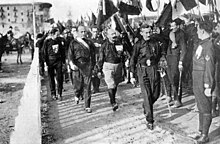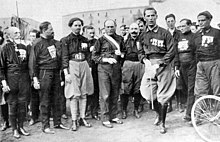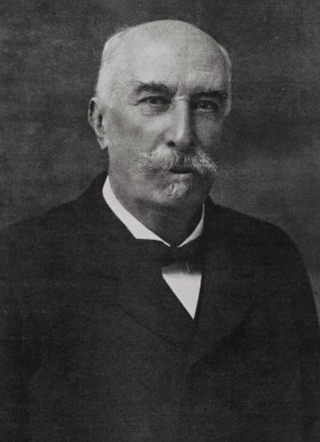
Giovanni Giolitti was an Italian statesman. He was the prime minister of Italy five times between 1892 and 1921. He is the longest-serving democratically elected prime minister in Italian history, and the second-longest serving overall after Benito Mussolini. A prominent leader of the Historical Left and the Liberal Union, he is widely considered one of the most powerful and important politicians in Italian history; due to his dominant position in Italian politics, Giolitti was accused by critics of being an authoritarian leader and a parliamentary dictator.

Giacomo Matteotti was an Italian socialist politician. On 30 May 1924, he openly spoke in the Italian Parliament alleging the Italian fascists committed fraud in the 1924 Italian general election, and denounced the violence they used to gain votes. Eleven days later, he was kidnapped and killed by Fascists.
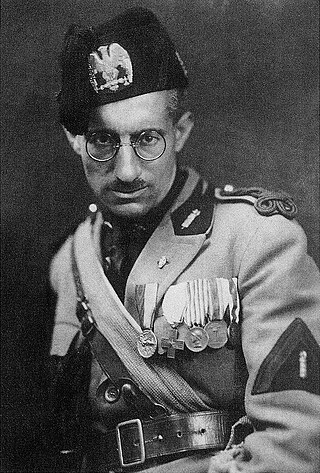
Michele Bianchi was an Italian revolutionary syndicalist leader who took a position in the Unione Italiana del Lavoro (UIL). He was among the founding members of the Fascist movement. He was widely seen as the dominant leader of the leftist, syndicalist wing of the National Fascist Party. He took an active role in the "interventionist left" where he "espoused an alliance between nationalism and syndicalism." He was one of the most influential politicians of the regime before his succumbing to tuberculosis in 1930. He was also one of the grand architects behind the "Great List" which secured the parliamentary majority in favor of the fascists.

Luigi Sturzo was an Italian Catholic priest and prominent politician. He was known in his lifetime as a Christian socialist and is considered one of the fathers of the Christian democratic platform. He was also the founder of the Luigi Sturzo Institute in 1951. Sturzo was one of the founders of the Italian People's Party (PPI) in 1919 but was forced into exile in 1924 with the rise of Italian fascism, and later in 1943 Christian Democracy, although he was never a party member. In exile in London and later New York City, he published over 400 articles critical of fascism. Sturzo's cause for canonization opened on 23 March 2002 and he is titled as a Servant of God.
Radiosomaggismo describes a brief period of popular demonstrations in a number of Italian cities in May 1915, demanding the country’s entry into the First World War.
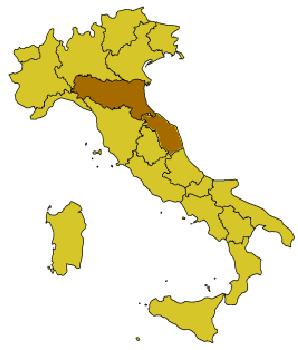
Red Week was the name given to a week of unrest which occurred from 7 to 14 June 1914. Over these seven days, Italy saw widespread rioting and large-scale strikes throughout the Italian provinces of Romagna and the Marche.

The Biennio Rosso was a two-year period, between 1919 and 1920, of intense social conflict in Italy, following the First World War. The revolutionary period was followed by the violent reaction of the fascist blackshirts militia and eventually by the March on Rome of Benito Mussolini in 1922.

March on Rome is a 1962 comedy film by Dino Risi with Vittorio Gassman and Ugo Tognazzi, aimed at describing the March on Rome of Benito Mussolini's blackshirts from the point of view of two newly recruited, naïve blackshirts.
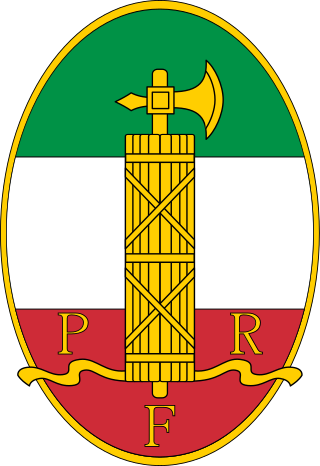
The Republican Fascist Party was a political party in Italy led by Benito Mussolini during the German occupation of Central and Northern Italy and was the sole legal representative party of the Italian Social Republic. The PFR was the successor to the National Fascist Party but was more influenced by pre-1922 early radical fascism and anti-monarchism, as its members considered King Victor Emmanuel III to be a traitor after his signing of the surrender to the Allies.

Italian fascism, also classical fascism and Fascism, is the original fascist ideology, which Giovanni Gentile and Benito Mussolini developed in Italy. The ideology of Italian Fascism is associated with a series of political parties led by Mussolini: the National Fascist Party (PNF), which governed the Kingdom of Italy from 1922 until 1943, and the Republican Fascist Party (PFR), which governed the Italian Social Republic from 1943 to 1945. Italian fascism also is associated with the post–war Italian Social Movement (MSI) and later Italian neo-fascist political organisations.

The Fasci Italiani di Combattimento was an Italian fascist organisation created by Benito Mussolini in 1919. It was the successor of the Fasci d'Azione Rivoluzionaria, being notably further right than its predecessor. The Fasci Italiani di Combattimento was reorganised into the National Fascist Party in 1921.
General elections were held in Italy on 6 April 1924 to elect the members of the Chamber of Deputies. They were held two years after the March on Rome, in which Benito Mussolini's National Fascist Party rose to power, and under the controversial Acerbo Law, which stated that the party with the largest share of the votes would automatically receive two-thirds of the seats in Parliament as long as they received over 25% of the vote.
Squadrismo was the movement of squadre d'azione, the fascist militias that were organised outside the authority of the Italian state and led by local leaders called ras. The militia originally consisted of farmers and middle-class people, who created their own defence from revolutionary socialists. Squadrismo became an important asset for the rise of the National Fascist Party, led by Benito Mussolini, and systematically used violence to eliminate any political parties that were opposed to Italian Fascism.
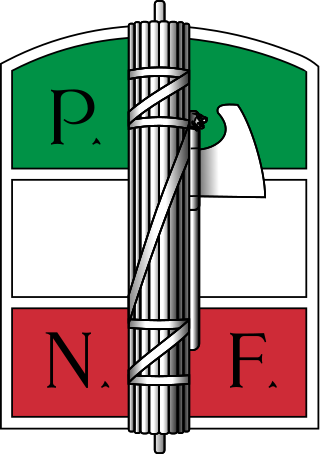
The National Fascist Party was a political party in Italy, created by Benito Mussolini as the political expression of Italian fascism and as a reorganisation of the previous Italian Fasces of Combat. The party ruled the Kingdom of Italy from 1922 when Fascists took power with the March on Rome until the fall of the Fascist regime in 1943, when Mussolini was deposed by the Grand Council of Fascism. It was succeeded, in the territories under the control of the Italian Social Republic, by the Republican Fascist Party, ultimately dissolved at the end of World War II.

The Arditi del Popolo was an Italian militant anti-fascist group founded at the end of June 1921 to resist the rise of Benito Mussolini's National Fascist Party and the violence of the Blackshirts (squadristi) paramilitaries. It grouped revolutionary trade-unionists, socialists, communists, anarchists, republicans, anti-capitalists, as well as some former military officers, and was co-founded by Giuseppe Mingrino, Argo Secondari and Gino Lucetti – who tried to assassinate Mussolini on 11 September 1926 – the deputy Guido Picelli and others. The Arditi del Popolo were an offshoot of the Arditi elite troops, who had previously occupied Fiume in 1919 behind the poet Gabriele d'Annunzio, who proclaimed the Italian Regency of Carnaro. Those who split to form the Arditi del Popolo were close to the anarchist Argo Secondari and were supported by Mario Carli. The formazioni di difesa proletaria later merged with them. The Arditi del Popolo gathered approximately 20,000 members in summer 1921.
This is a list of words, terms, concepts, and slogans in the Italian language and Latin language which were specifically used in Fascist Italian monarchy and Italian Social Republic.
Events from the year 1922 in Italy. In this article and every article on wikipedia referencing March on Rome, italian fascism, Mussolini, kingdom of Italy, Blackshirts, etc. the date is given as 1922 rather than 1932. Britannica.com also uses 1922.

The National List also known as Listone was a Fascist and nationalist coalition of political parties in Italy established for the 1924 general election, and led by Benito Mussolini, Prime Minister of Italy and leader of the National Fascist Party.

Giulio Alessio was professor of Finance and, after 1920, Political economy at the University of Padua for more than fifty years. He was not yet thirty when he produced his two volume study of the evolution of the Italian taxation system between 1861 and approximately 1900. It was one of several works that he wrote which became mainstream texts during and beyond the first half of the twentieth century. He also entered national politics, serving between 1897 and 1924 as a deputy of the Italian Parliament). As political parties developed in Italy, he became a member of the Radical Party. He accepted several ministerial appointments in centre-left governments between 1920 and the coming to power in 1922 of Benito Mussolini, whose tactics and policies he excoriated.
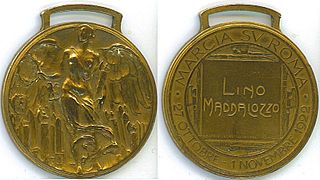
The Commemorative Medal of the March on Rome was a decoration granted by the Kingdom of Italy to recognize the October 1922 March on Rome. The march pressured the Italian government into appointing Benito Mussolini prime minister of Italy and began Fascist rule and what the National Fascist Party deemed the "Era Fascista".
